- Mazda 626
-
Mazda 626 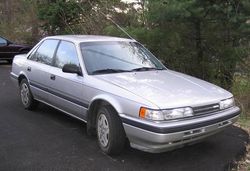
Manufacturer Mazda
AutoAlliance InternationalProduction 1979–2002 Predecessor Mazda 616/618 Successor Mazda Atenza/Mazda6 Class Europe: Large family car
North America:
Compact (1977-1987)
Mid-size (1988-2002)The Mazda 626 is an automobile that was produced by Mazda for the export market. It was based on the Japan-market Mazda Capella. The 626 replaced the 616/618 and RX-2 in 1979 and was sold through 2002, when the new Mazda6 took over as Mazda's large family car. 4,345,279 of the 626 and Ford Telstar models were sold worldwide.
The 626 was also sold as the Ford Telstar in Asia, Australasia and Southern Africa, but was later replaced by the European-sourced Ford Mondeo. While in Europe it was always considered a large family car, in North America the first two generations of the 626 were compact cars, and the third, fourth and fifth were mid-size cars.
Contents
Predecessors
The 1971 model 616 and 1972 model 618 had been modest successes in the United States, each lasting just a single year. By 1980, the American public was ready for a compact piston-engined Mazda, and the 626 has been a top seller for the marque ever since.
CB (1978-1982)
Mark 1 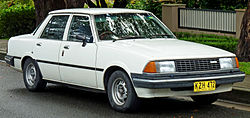
Production 1978–1982 Assembly Hiroshima, Japan Body style 2-door coupe
4-door sedanLayout FR layout Engine 2.0 L F/MA I4 Transmission 5-speed manual
3-speed automaticWheelbase 98.8 in (2,510 mm) Length 173.8 in (4,410 mm) Related Mazda Capella
Mazda MontroseThe first Mazda 626, the CB series, appeared in 1978, although most the model's introduction to most markets was delayed until 1979. The 626 was a front engined rear-wheel drive compact, little changed from the Japan-market Mazda Capella with an 80 hp (60 kW) 2.0 L SOHC straight-4 F/MA engine and featuring a split-folding rear seat.
The coupe and sedan were mechanically identical with front MacPherson struts and a solid axle in back mounted on four links and riding on coil springs, either a 5-speed manual or three-speed automatic transmission and recirculating ball steering.[1]
Mazda facelifted the CB series 626 in 1980. The update brought flush-fitting headlamps and a new grille insert. The grille was lengthened slightly to remove the body-colored gap between the headlamps and grille on the original model. It was also reduced in height so that the grille and headlamps formed a single "band" across the front-end.
Model Years Engine Power Torque All 1979 2.0 L F/MA I4 80 hp (60 kW) 1979–1982 2.0 L F/MA I4 75 hp (56 kW) Pre-facelift Mazda 626 sedan (Australia)Facelift Mazda 626 sedan (Australia)GC (1982-1987)
Mark 2 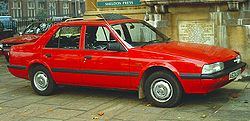
Production 1982–1987 Assembly Hiroshima, Japan
Hofu, Japan
Bogotá, ColombiaBody style 2-door coupe
4-door sedan
5-door hatchbackLayout FF layout Platform Mazda GC platform Engine 1.6 L F6
2.0 L FE I4
2.0 L FET I4
2.0 L RF I4Transmission 5-speed manual
3-speed automatic
4-speed automaticWheelbase 98.8 in (2,510 mm) Length 177.8 in (4,520 mm) Related Ford Telstar
Kia Concord
Mazda CapellaThe front-wheel drive model appeared in September 1982 with the GC platform. It was named Import Car of the Year by Motor Trend magazine and Car of the Year by Wheels magazine for 1983. The new 2.0 L FE engine was up to 83 hp (62 kW) for the North American market. In other regions including Finland, the 626 offered 101 hp (75 kW) with a twin barrel carburetor. The rear suspension was now independent, and though the wheelbase remained the same as the previous model, it was an entirely different car. A SOHC non-turbo diesel 2.0 L RF 66 hp (49 kW) engine was made available; twenty examples were imported officially into Australia from 1983 to 1987. European markets also received a 1.6 L F6 80 hp (60 kW) engine.[2]
A 626 GT (also called the Turbo) was introduced in 1986 using the 120 hp (89 kW) and 150 lb·ft (200 N·m) FET engine. The rest of the line got a new front clip with dual (rather than quad) headlights and an entirely new interior, and fuel injection on the base engine meant 93 hp (69 kW). A new four-speed automatic was introduced for 1987, the last year of this series.
Model Years Engine Power Torque Base 1983–1985 2.0 L FE I4 83 hp (61 kW) 1986–1987 2.0 L FE I4 93 hp (69 kW) Diesel 1984–1987 2.0 L RF I4 66 hp (49 kW) Europe 1982–1987 1.6 L F6 80 hp (60 kW) 89 ft-lbf (120 Nm) Finland Etc 1982–1987 2.0 L FE I4 101 hp (75 kW) GT 1986–1987 2.0 L FET I4 120 hp (89 kW) 150 ft-lbf (203 Nm) GD (1987-1992)
Mark 3 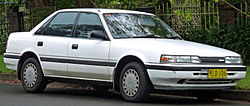
Also called Ford Telstar Production 1988–1992 Assembly Flat Rock, Michigan, United States
Hiroshima, Japan
Hofu, Japan
Bogotá, ColombiaBody style 4-door sedan
5-door hatchback
2-door coupé
5-door station wagonLayout FF layout Platform Mazda GD platform Engine 2.2 L F2 I4
2.2 L F2T I4
2.0 L FE-DOHC I4Transmission 5-speed manual
4-speed automaticWheelbase 101.4 in (2,580 mm) Length 179.3 in (4,550 mm) Width 66.5 in (1,690 mm) Height Hatchback: 54.1 in (1,370 mm)
Sedan: 55.5 in (1,410 mm)Related Mazda MX-6
Mazda CapellaThe 626 was updated in 1987 for the 1988 model year. Now on the GD platform as used by the Capella, it was available as a sedan, Station Wagon (Estate) and five-door hatchback while the coupé was renamed MX-6 for the North American market. The MX-6 was built in Michigan alongside its platform-mate, the Ford Probe at AutoAlliance International, while the 626 was still a Japanese import.
Consumer response was strong, and Car and Driver magazine named the 626 and MX-6 in their Ten Best list for 1988.
Engines were new, though still emphasized torque rather than power. The base model now used Mazda's 110-horsepower 2.2 L 3-valve SOHC F2 producing just 6 hp (4.5 kW) shy of the old Turbo, and the new Turbo was up to 145 hp (108 kW). European versions used 1.6, 1.8, 2.0 and 2.2 (non-turbo) engines. The GT model had a 2.0 liter FE-DOHC engine that produced 148 (non-cat) or 140 hp (cat).
4-wheel-steering was introduced to the 626 Turbo in 1988 (to mixed reviews) and was transferred to the MX-6 Turbo a year later. Mazda's system was electronic and more complex than the 4WS system introduced by Honda on the 1988 Prelude; these two marked the first 4WS systems for the American market. This system was still available in Japanese markets for some time after.
It came in 3 bodies: Sedan (Saloon), Hatchback and Station Wagon (Estate). The Station wagon also having a 7 seat option. All of the bodies also had an ABS option. the final face lift was available with a driver airbag.
The 626 line was face-lifted for 1990 and gained motorized seat-belts in the USA market. 626 hatchbacks disappeared after 1991 from the US Mazda model range. The Station Wagon (Estate) was still available up until 94.
UK trim levels were LX (1.8-litre), GLX (1.8/2.0) and GT (2.0/2.2). There was also an estate model with either the 2.0i 8v or 16v engine, or the 2.2 12v.
1990–1992 Mazda 626 sedan (Australia)1995–1997 Mazda 626 wagon (Australia)Model Years Engine Power Torque Base (North America) 1988–1992 2.2 L F2 I4 115 hp (86 kW) 130 lb·ft (180 N·m) GT (North America) 1988–1992 2.2 L F2T I4 turbo 145 hp (108 kW) 190 lb·ft (260 N·m) GT 1987–1992 2.0 L FE-DOHC I4 140/148 hp (103/108 kW) GE (1993-1997)
Mark 4 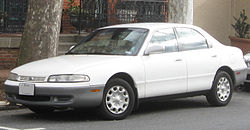
Also called Mazda 626 Cronos
Ford TelstarProduction 1993–1997 Assembly Flat Rock, Michigan, United States
Hiroshima, Japan
Hofu, Japan
Bogotá, ColombiaBody style 4-door sedan
5-door hatchbackLayout FF layout Platform Mazda GE platform Engine 2.0 L F I4
2.5 L KL V6Transmission 5-speed manual
4-speed automaticWheelbase 102.8 in (2,610 mm) Length 184.4 in (4,680 mm) Width 68.9 in (1,750 mm) Height 1993-95: 53.9 in (1,370 mm)
1996-97: 55.1 in (1,400 mm)Related Mazda MX-6
Mazda Cronos
Ford ProbeIn 1993 the Mazda 626 saw big changes in body style and powertrain since the 626 moved to an entirely different platform. It was now based on the GE platform. The 626 was again Wheels magazine's Car of the Year for a second time in 1992. The very first 1993 Mazda 626 was assembled in Flat Rock, Michigan on September 1, 1992. The car was known as the Cronos in Canada, but dropped the Cronos for the 1996 model year.
New transmissions were designed to give the car more of a "sports car" feel, and production was moved to AutoAlliance International alongside the MX-6 and Ford Probe. This, and the car's component sources, allowed the 626 to be certified as the first official Japanese-branded U.S. domestic automobile. The wagon and hatchback models were not offered in the U.S. but were well received in Europe, Asia, and Australia.
Mazda's 2.5 L V6 engine (enlarged from the 1.8 L V6 on the 1992 MX-3) debuted to rave reviews. The Japanese MX-6 KL-ZE would later become a highly sought after upgrade by 93-97 626 owners as it supplies 200 horsepower compared to the U.S. version KL-DE's stock 170hp. Though the 626's manual transmission was highly regarded,[3] 4-cylinder 626s from 1994 onwards used the Ford CD4E automatic transmission (designated by Mazda as LA4A-EL) which was an attempt to solve some of the 1993's transmission related issues.
Unfortunately, it wasn't until a few years later that the 1994 to 1997 CD4E became known for their extremely high failure rate making the change to the CD4E an irrelevant one. It's widely known to transmission specialists that the CD4E overheats due to a poorly designed valve body and torque converter. Mazda issued a couple of Technical Service Bulletins (0400502, 01598, 003/97K, 006/95) regarding the transmission and torque converter. Dealerships were briefly instructed to install an external transmission cooler but at cost to the owner and only if requested. No recall was ever issued for a single year of the CD4E causing a loss of confidence from the general public in years to come.
Also in 1994, a passenger side airbag was added, and the V6 spread to the LX trim in addition to the leather ES trim. Some models of the 1994 & 1995 Mazda 626, Mazda MX-6, and Ford Probe 2.0L automatics were outfitted with Ford's EEC-IV diagnostic system. New for 1996 & 1997 models were a redesigned hood (raised center portion), chrome grille fairing (attached to the hood), and the introduction of the On Board Diagnostics II revision (OBD-II).
In Colombia the car was named 626 Matsuri to differentiate from the past version that was sold at the same time.
Model Years Engine Power Torque European 1993–1997 1.8 L F I4 104 hp (78 kW) 127 lb·ft (172 N·m) Base 1993–1997 2.0 L FS I4 118 hp (88 kW) 127 lb·ft (172 N·m) V6 1993–1997 2.5 L KL V6 164 hp (122 kW) 160 lb·ft (217 N·m) 1998
Mark 5 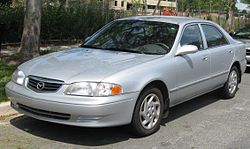
Also called Ford Telstar Production 1998–2002 Assembly Flat Rock, Michigan, United States
Hiroshima, Japan
Hofu, Japan
Bogotá, ColombiaBody style 4-door sedan Layout FF layout Platform Mazda GF platform Engine 1.8 L F I4 (Europe)
2.0 L F I4
2.5 L KLG4 V6Transmission 5-speed manual
4-speed automaticWheelbase 105.1 in (2,670 mm) Length 1998-99: 186.8 in (4,740 mm)
2000-02: 187.4 in (4,760 mm)Width 69.3 in (1,760 mm) Height 55.1 in (1,400 mm) Related Mazda Capella 1998 brought the fifth-generation 626, now on the GF platform. North American 626's were again built by AutoAlliance International in Flat Rock, Michigan. Its MX-6 and Ford Probe derivations were gone.
From 1997 through 1999 the 626 was given an engine overhaul to give it better pedal feel. However, as most car reviews will attest, it was a bland vehicle with softer handling and fewer features than the 1993–1997 version.[citation needed] Front side airbags were new options for 2000, as were larger wheels, four wheel discs, and rear heat ducts. The four cylinder engine was also uprated by 5 hp (3.7 kW).
The Mazda 626 GLX is a trim level of the Mazda 626. It is, with a 2.0L 4-cylinder DOHC-engine (FS), 4-speed automatic transmission Japanese made, which produces 125 hp (93 kW) at 6000 rpm and 133 ft·lbf (180 N·m) at 4000 rpm.
The final Mazda 626 rolled off the Flat Rock, Michigan assembly plant on August 30, 2002.
In Colombia the car was built until 2006, replaced by Mazda 6.
Model Years Engine Power Torque Europe 1998–2002 1.8 L F I4 100 hp (75 kW) Base 1998–1999 2.0 L F I4 125 hp (93 kW) 127 lb·ft (172 N·m) 2000–2002 2.0 L F I4 130 hp (97 kW) 135 lb·ft (183 N·m) V6 1998–2002 2.5 L KLG4 V6 170 hp (130 kW) 163 lb·ft (221 N·m) 2002
Mark 6 Concept Production Concept Only Body style 4-door sedan Engine 2.5 L KLZE V6 Transmission 5-speed manual Wheelbase 102.8 in (2,610 mm) Length 181.0 in (4,600 mm) Width 70.0 in (1,780 mm) Height 55.5 in (1,410 mm) In 2000-2001 Mazda built the 626 MPS which was to be the 2002 Mazda 626. It debuted at the 2000 Geneva motor show as a concept car and only a few were ever produced. It was very similar in appearance to the Mazda 6 but boasted classic 626 exterior and interior features such as the familiar 626/MX-6 headlights, front grille, gauge cluster, and oscillating air conditioning vents. The hood although highly stylized was still directly in line with 626 styling making it one of the best 626's ever designed. Portions of the center console were redesigned to be slimmer for more leg room, cup holders moved, new window control units based on the 2000-2002 model, and according the concept car images 3 more gauges located in the center dash presumably for oil pressure, temperature, and boost).
It would have included a new twin turbo 2.5L 280hp re-design of the legendary KL-ZE engine. The KL-ZE (KL31) engine has become a performance staple for those upgrading their 1993-1997 Probe,MX-6,626,Telstar,Protege,etc... to a high performance engine. A new version of the KL-ZE would have been extremely welcomed not just by Mazda 626 owners but by all Mazda enthusiasts. To the utter dismay of Mazda enthusiasts across the world the 626 MPS was never realized as the next generation of the 626.
References
- ^ "Mazda MAZDA6 History". edmunds.com. http://www.edmunds.com/mazda/mazda6/history.html.
- ^ "1983 Mazda 626 1.6 Hatchback Automatic technical specifications". Carfolio.com. http://www.carfolio.com/specifications/models/car/?car=180873. Retrieved 2011-08-08.
- ^ The Spokesman-Review, Page D3, 17 August 1996
External links
- Mazda626.net Home of the Mazda 626 Enthusiast
- Mazda626.net Home of the Mazda 6 Enthusiast
« previous — Mazda road car timeline, 1990s–present Type 1990s 2000s 2010s 0 1 2 3 4 5 6 7 8 9 0 1 2 3 4 5 6 7 8 9 0 1 Kei car Carol Carol Carol Carol Carol AZ-Wagon AZ-Wagon AZ-Wagon AZ-Wagon AZ-Offroad Spiano Scrum Scrum/Scrum Wagon Scrum/Scrum Wagon Subcompact Revue/121 Demio/121 Demio/Mazda2 Demio/Mazda2 Verisa Compact Familia/323/Protegé Familia/323/Protegé Familia/323/Protegé Axela/Mazda3 Axela/Mazda3 Familia Van Familia Van Familia Van Mid-size Capella/626 Capella Capella/626 Atenza/Mazda6 Atenza/Mazda6 Cronos/626/Xedos 6/Eunos 500 Eunos 800/Xedos 9/Millenia Mazda6 (N.America) Full-size Sentia/929/Efini MS-8 Sentia Sports car AZ-1 MX-3 Precidia Roadster/MX-5/Miata Roadster/MX-5/Miata Roadster/MX-5 MX-6/Mystère MX-6/Mystère/Efini MS-6 RX-7 Efini RX-7/RX-7 RX-8 Cosmo Minivan Premacy Premacy/Mazda5 Premacy/
Mazda5Bongo Friendee Biante Efini MPV/MPV MPV MPV/Mazda8 Crossover CX-7 CX-9 SUV Navajo Tribute Tribute Pickup B-Series B-Series B-Series BT-50 BT-50 Van Bongo Bongo Mazda automobile timeline, North American market, 1980s–present Type 1980s 1990s 2000s 2010s Model year 0 1 2 3 4 5 6 7 8 9 0 1 2 3 4 5 6 7 8 9 0 1 2 3 4 5 6 7 8 9 0 1 Subcompact GLC GLC Mazda2 323 323/Protegé Compact Protegé Protegé Mazda3 Mazda3 626 626 626 Mid-size 626 626 Mazda6 Mazda6 Millenia Full-size 929 929 Sport compact MX-3 MX-6 MX-6 Sports MX-5 Miata MX-5 Miata MX-5 RX-7 RX-7 RX-7 RX-8 Minivan Mazda5 MPV MPV Mid-size crossover CX-7 Full-size crossover CX-9 SUV Navajo Tribute Tribute Pickup B-Series B-Series B-Series B-Series Categories:- Mazda vehicles
- Front wheel drive vehicles
- Rear wheel drive vehicles
- Compact cars
- Mid-size cars
- Motor vehicles manufactured in the United States
- 1970s automobiles
- 1980s automobiles
- 1990s automobiles
- 2000s automobiles
Wikimedia Foundation. 2010.


















